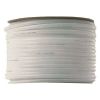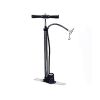Solinst Model 425 Discrete Interval Sampler
Features
- Avoids purging and disposal of purged water
- Obtain high quality discrete zone samples
- Profile wells or open bodies of water
- Free ground shipping
- Expedited repair and warranty service
- Lifetime technical support
- More
Overview
The Solinst Model 425 Discrete Interval Sampler is a stainless steel groundwater sampler designed for use with LDPE tubing mounted on a reel. The reel has a pressure attachment for a high-pressure hand pump and a pressure/vent switch, which is used to apply and release the pressure on the sampler. A sample release device is included with each standard Discrete Interval Sampler.
Applications
Discrete interval sampling is ideal for obtaining truly representative groundwater samples from below floating product layers, or for obtaining samples of the product itself. The discrete interval sampler can also be used to profile open bodies of water and boreholes, and to collect samples from distinct levels or points of inflow. The Discrete Interval Sampler is a passive sampler that is pressurized when lowered and upon retrieval to prevent water from mixing at different levels. Designed to give zero purge samples.
Models
Solinst also offers the Model 425-D Deep Sampling Discrete Interval Sampler for obtaining samples from submerged depths as much as 1200m (4000 ft). Biodegradable disposable PVC bailers and stainless steel Point Source Bailers are also available.
- (1) Model 425 Discrete Interval Sampler
- (1) Sample Release Device
In The News
From Paddles to Phytoplankton: Studying Vermont’s Wildest Lakes
For six months of the year, Rachel Cray, a third-year PhD student at the Vermont Limnology Laboratory at the University of Vermont, lives between a microscope and her laptop, running data. For the other six months, she is hiking and canoeing four of Vermont’s lakes, collecting bi-weekly water samples. Cray studies algal phenology across four lakes in Vermont, US, that have low anthropogenic stress—or in other words, are very remote. Funded by the National Science Foundation Career Award to Dr. Mindy Morales, the lakes Cray researches part of the Vermont Sentinel Lakes Program, which studies 13 lakes in the area and, in turn, feeds into the Regional Monitoring Network, which operates in the Northeast and Midwest US.
Read MoreReimagining Water Filtration: How Monitoring and Science Enhance FloWater Filtration Systems
Over 50% of Americans think their tap water is unsafe , according to the Environmental Working Group (EWG). Other recent surveys have found that number to be as high as 70% of persons surveyed. Whether due to increased public awareness of water quality issues or confusion about how municipal water sources are regulated, there is a clear distrust of tap water in the United States. According to industry expert Rich Razgaitis, CEO and co-founder of the water purification company FloWater, this issue creates a damaging cycle. Razgaitis explained that the health and environmental problems associated with contaminated water aren’t the only issues. As people become increasingly aware that some tap water is unsafe, they resort to bottled water.
Read MoreMonitoring New Hampshire’s Aquatic Ecosystems: Continuous Data Collection in the Lamprey River Watershed
New Hampshire’s aquatic ecosystems provide a range of ecosystem services to the state and region. Resources and services like clean water, carbon storage, climate regulation, nutrient regulation, and opportunities for recreation all depend on New Hampshire’s aquatic ecosystems remaining healthy. Jody Potter, an analytical instrumentation scientist at the University of New Hampshire (UNH), is studying these aquatic ecosystems in hopes of developing an improved understanding of ecosystem services and their interactions with climate change, climate variability, and land use changes. [caption id="attachment_39799" align="alignnone" width="940"] Aquatic sensors in the Merrimack River in Bedford, NH, with I-293 in the background.
Read More






















